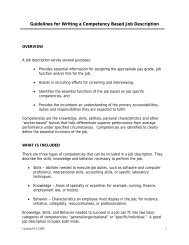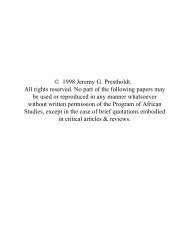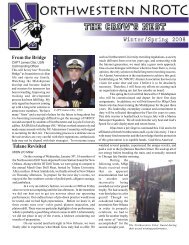TRAGIC RECOGNITION: ACTION AND IDENTITY IN ANTIGONE ...
TRAGIC RECOGNITION: ACTION AND IDENTITY IN ANTIGONE ...
TRAGIC RECOGNITION: ACTION AND IDENTITY IN ANTIGONE ...
Create successful ePaper yourself
Turn your PDF publications into a flip-book with our unique Google optimized e-Paper software.
At first glance, the Antigone doesn’t seem to contain anything like the archetypal<br />
“recognition scenes” of Greek literature: Odysseus gradually revealing himself after returning to<br />
Ithaca in disguise; Oedipus discovering that he himself is the murderer whose identity he has<br />
sworn to discover; Electra finding traces of and finally recognizing Orestes at Agamemnon’s<br />
tomb. 16 Yet even without telltale scars and familiar locks of hair, the Antigone is full of<br />
recognitions. The conflict with which the play begins is essentially a controversy about how to<br />
recognize Polyneices; moreover, that controversy involves two adversaries who ground their<br />
actions in confident claims about who Polyneices is, and also, as we shall see, in claims about<br />
their own identities. In this way, the opening of the Antigone models the theoretical<br />
underpinnings of the contemporary politics of recognition: the antagonists attempt to ground<br />
their own actions in their knowledge of identities, and, on the basis of these properly cognized<br />
identities, to secure respect from others. 17<br />
The question of recognition first arises with respect to the dead Polyneices, whose body<br />
is the principal object of controversy in the Antigone. The idea of a conflict over the burial of<br />
bodies was probably not original with Sophocles. Attic funeral orators often recalled the story of<br />
Thebes’ refusal to allow the burial of the corpses of the invading Argive army, which supposedly<br />
provoked a heroic Athenian expedition to recover the bodies. 18 But these were simple, self-<br />
congratulatory stories of Athenian virtue in the face of sheer impiety, and not the stuff of deep<br />
ethical conflict. 19 Sophocles’ version of the story focuses our attention on problems of identity<br />
and recognition by zeroing in on the disparate treatment of Eteocles and Polyneices. 20 The case<br />
of Polyneices and Eteocles is distinctive, because the question of how to deal with Polyneices’<br />
body seems to hangs on who he is—and he can be recognized under two incompatible<br />
descriptions, each of which highlights one aspect of his relationship to Eteocles. On the one<br />
6














